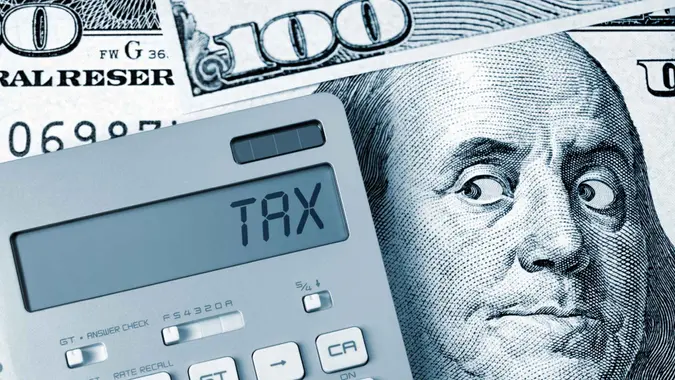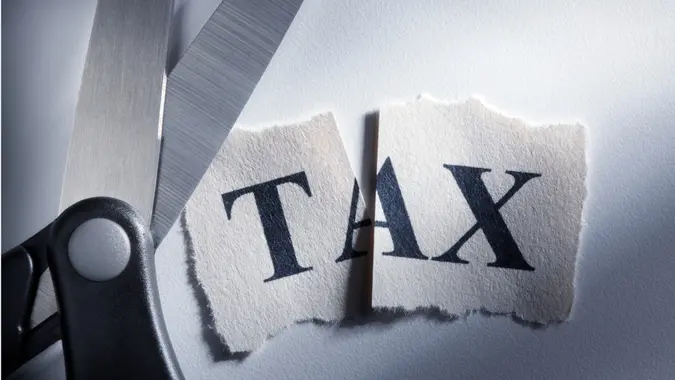What Is the OASDI Tax on Your Paycheck?

Commitment to Our Readers
GOBankingRates' editorial team is committed to bringing you unbiased reviews and information. We use data-driven methodologies to evaluate financial products and services - our reviews and ratings are not influenced by advertisers. You can read more about our editorial guidelines and our products and services review methodology.

20 Years
Helping You Live Richer

Reviewed
by Experts

Trusted by
Millions of Readers
There are a lot of things that come out of your paycheck before you ever see them. State and federal income taxes are withheld, and you may be paying for benefits like health insurance or 401(k) contributions. But there’s one line item on your pay stub that you may not be as familiar with — the OASDI tax.
What Is the OASDI Tax?
OASDI stands for Old-Age, Survivors, and Disability Insurance, and money is withheld from most Americans’ paychecks to fund the program. More popularly known as Social Security, this is the program that pays for the retirement benefits you will collect after you stop working in your 60s. It also pays benefits to survivors of workers who would have qualified, and those who become disabled and cannot work.
The OASDI tax is a component of the FICA tax, which stands for the Federal Insurance Contributions Act. FICA includes OASDI tax and Medicare tax, which funds healthcare for retirees. You may see FICA as a tax line item on your paycheck instead of OASDI.
How Much Is the OASDI Tax?
The total OASDI tax for 2023 is 12.4% of your income — the percentage has remained unchanged since 1990.
The tax is split between the employee and the employer. So, you pay 6.2% and your employer pays 6.2% of your income.
When you retire or become disabled, the amount you can collect is based on the amount you earned while working, up to a specific limit.
At What Amount Does OASDI Tax Stop?
The income subject to OASDI tax is capped at $168,600 in 2024, up from $160,200 in 2023. The reason for the cap is that the amount of Social Security and disability benefits you can receive is also capped. For example, if you retire in 2024 at age 70, you cannot collect more than $4,873 per month, even if you made millions every year while working.
The income cap is adjusted each year according to changes in the national average wage index.
How Much OASDI Tax Do I Have To Pay in 2024?
You’ll have to pay 6.2% of your wages. What that works out to depends on how much you earn. But because only your first $168,600 is subject to OASDI tax, the most you’ll pay is $10,453.20.
OASDI Tax Example
Joe earns $75,000 per year and gets paid every week. His gross pay is $1,442.30 per week. Every week, $89.42 is withheld from his paycheck for the OASDI tax, or 6.2% of $75,000 divided by 52 weeks. His employer also pays $89.42 in OASDI tax each week.
Jane earns $250,000 per year and is paid every two weeks. Her gross pay is $9,615.38 every two weeks. Because her income is over the OASDI cap of $168,600, she only pays OASDI tax on the first $168,600 of her income. So, the amount withheld from each of her paychecks is $402.05, which is 6.2% of $168,600 ($10,453.20) divided by 26 paychecks.
OASDI Tax and Self-Employment
If you are self-employed, you are both the employer and the employee. Therefore, you have to pay both parts of the OASDI tax, a total of 12.4% of your pay. Note, however, that the tax isn’t called OASDI. The self-employed version is called the SECA tax, for Self-Employment Contributions Act — or simply, self-employment tax. SECA includes 12.4% Social Security tax and 2.9% Medicare tax, so the rate is 15.3%. You pay it on your net self-employment earnings. Net earnings are your gross earnings less your business deductions.
The IRS gives self-employed individuals a tax write-off of one-half of the self-employment tax.
If you do not withhold taxes on your pay as a self-employed person, it’s a good idea to make quarterly OASDI payments along with your quarterly state and federal tax payments. This will prevent you from having to make a big tax payment when you file your taxes.
Is OASDI Tax Mandatory?
OASDI tax is mandatory for nearly every worker in the U.S. There are some exceptions, such as academic workers or researchers who do not have U.S. citizenship or permanent resident status, and specific religious organizations.
If you are a state or federal employee who is covered under a public retirement plan, you usually will not pay OASDI. This is because when you retire, you will collect benefits from your retirement plan, and not from Social Security.
Do I Get OASDI Money Back?
As long as you qualify for Social Security benefits, you’ll get your OASDI money back in the form of benefit checks after you retire.
The only way to have OASDI money refunded is if your employer withheld too much from your paychecks. In the case of a single employer withholding too much, the IRS recommends bringing it to the employer’s attention and asking them to make an adjustment. If they won’t, you can use Form 843, Claim for Refund and Request for Abatement, to claim a refund.
If you had two or more employers over the year and your income was more than $168,600, it’s possible that you overpaid OASDI tax (or the equivalent railroad retirement tax). In that case, you might be able to claim it as a credit against any federal income tax you owe. That credit could result in a refund if it reduces your tax to less than $0.
Final Take
OASDI tax seems like a big chunk out of your paycheck, especially if you are self-employed. But withholding these funds is important, as it pays for the income you will get from Social Security if you are disabled or when you retire. While Social Security doesn’t replace all of the income you earned in your working years, it is an important safety net for most Americans.
FAQ
Here are the answers to some of the most frequently asked questions regarding OASDI tax and other tax topics.- Why am I paying OASDI tax?
- OASDI tax funds the Old-Age, Survivors, and Disability Insurance program, which pays Social Security benefits to retirees, survivors and disabled people. Nearly every American worker pays into the program through this tax, so nearly every American worker can benefit from it after they retire or become disabled, or the person who provided for them dies.
- Can I opt out of OASDI tax?
- No. The OASDI system is designed based on all workers participating. There are some very narrow exceptions, but in general, if you are earning wages for work in the U.S., you will pay OASDI tax, and your employer will pay the same amount on your behalf.
- What is the FICA tax rate?
- The FICA tax rate is 15.3% of your gross wages. The tax is divided between Social Security, which receives 6.2%, and Medicare, which receives 1.45%. If you're a W-2 employee, your employer pays half.
- What is the capital gains tax rate?
- Short-term capital gains are taxed at your federal income tax rate. Long-term capital gains tax rates vary from 0% to 20%, depending on your income.
- How long does it take to get a tax refund?
- Most taxpayers receive their refunds within 21 days, according to the IRS, but how long it takes to get your refund depends on whether you request a check or direct deposit (direct deposit is faster) and whether your return requires additional review.
Daria Uhlig contributed to the reporting for this article.
Our in-house research team and on-site financial experts work together to create content that’s accurate, impartial, and up to date. We fact-check every single statistic, quote and fact using trusted primary resources to make sure the information we provide is correct. You can learn more about GOBankingRates’ processes and standards in our editorial policy.
- Social Security Administration. "Contribution And Benefit Base."
- Social Security Administration. 2024. "What is the maximum Social Security retirement benefit payable?"
- IRS. 2024. "Topic no. 608, Excess Social Security and RRTA tax withheld."
- IRS. 2024. "2024 tax filing season set for January 29; IRS continues to make improvements to help taxpayers."
 Written by
Written by  Edited by
Edited by 


























